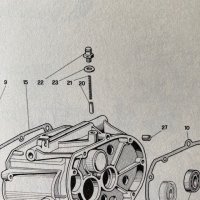Skivo
Tuned and Synch'ed
My V50ii (1980) is seeping oil during rides via the oil pressure relief valve. Curious about troubleshooting ideas. From what I have gathered, on these vintage machines the oil pressure relief system is a small spring-loaded device on top of the case, near where the engine case meets the transmission case. This is my first foray into Moto Guzzi.
This bike has been on the road only for a month or so now and I noticed oil is collecting on the top of the case after each ride. My thought is maybe the screen/oil strainer is partially clogged, causing an excess of pressure to build up? I have not dropped the pan. Hoping for some good troubleshooting ideas before I dig into that.

A bit of background on this machine...
The odometer is at 34,000 miles. Compression was in the 150-160 psi range back when I first began investigating this machine. I haven't checked it again since I got it running. Evidence of oil fouling on the plugs. With any luck, if I can restore the oil pressure to normal the oil fouling will be alleviated somewhat (is that too much wishful thinking?). It doesn't smoke and has decent compression but, like I said, the plugs do get oil fouled rather quickly. Makes me think the valve guides are leaking. It's probably time for a top-end rebuild, but I don't have the space for that or the time. For now I'm content to ride it around the neighborhood and clean the spark plugs every 50 miles ;-), if only I could get it to stop seeping oil... The machine is stock.
(I searched all the vintage small block threads before posting here; forgive me if I overlooked a better thread to attach this to.)
This bike has been on the road only for a month or so now and I noticed oil is collecting on the top of the case after each ride. My thought is maybe the screen/oil strainer is partially clogged, causing an excess of pressure to build up? I have not dropped the pan. Hoping for some good troubleshooting ideas before I dig into that.

A bit of background on this machine...
The odometer is at 34,000 miles. Compression was in the 150-160 psi range back when I first began investigating this machine. I haven't checked it again since I got it running. Evidence of oil fouling on the plugs. With any luck, if I can restore the oil pressure to normal the oil fouling will be alleviated somewhat (is that too much wishful thinking?). It doesn't smoke and has decent compression but, like I said, the plugs do get oil fouled rather quickly. Makes me think the valve guides are leaking. It's probably time for a top-end rebuild, but I don't have the space for that or the time. For now I'm content to ride it around the neighborhood and clean the spark plugs every 50 miles ;-), if only I could get it to stop seeping oil... The machine is stock.
(I searched all the vintage small block threads before posting here; forgive me if I overlooked a better thread to attach this to.)

